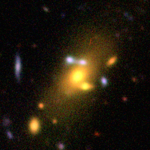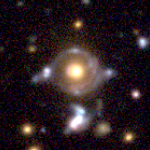Strong Gravitational Lensing
When light from a distant background source, such as a galaxy or quasar, is deflected into multiple paths by an intervening galaxy or a cluster of galaxies, we can see multiple images of the background source. This phenomenon is known as strong gravitational lensing.
Gravitational lens systems require a foreground lens and a background source to be almost perfectly aligned along a line of sight from us. Hence, gravitational lenses are quite rare. In addition to their spectacular appearance, these unique systems help us understand several interesting aspects of the Universe, which are described below.
Key Science Goals
- Dark Matter and its properties
Strong lensing allows us to accurately measure the total mass (including dark matter) of galaxies and clusters at cosmological distances. After accounting for the luminous matter in these systems through observations, we can infer the fraction of dark matter and put constraints on its mass distribution.
- Study of galaxies at high redshifts
The magnification due to lensing allows us to study physical properties such as the star formation rates and metallicities of very distant and young galaxies, which would be otherwise impossible. Statistically, magnification causes a boost in the detection of fainter sources in a magnitude-limited survey and can be used to constrain source luminosity functions.
- Assembly history of massive galaxies
Galaxies appear to grow as a result of mergers over time, but the details of this growth are largely unknown. A statistically significant sample of strong lens galaxies at different redshifts can be used to track the evolution of the internal structure of galaxies over cosmic time and gain insight on the key processes.
- Co-evolution of supermassive black holes and their host galaxies
Strongly lensed active galactic nuclei (AGNs) allow us to study the origin and evolution of the tight relations between properties of the supermassive black holes that power the AGNs and their host galaxies. Through lensing magnification of the background sources, we can observe more distant AGNs and measure physical properties of their host galaxies, which would otherwise be very difficult without the aid of lensing.
- Statistical probes
Statistical studies of lenses to quantify their image separations, abundances, and the orientation of their lensed arcs, are useful probes of the foreground lens population. These can be used to constrain physical properties such as their mass distribution and ellipticity (or triaxiality of dark matter halos), and can also allow us to constrain parameters of cosmological models of the Universe.
- Cosmology
Lensed sources that are intrinsically variable (such as quasars and supernovae) exhibit variabilities among the multiple images at different times due to the different paths taken by light rays to each of the images. By combining these time delays with a lens mass model and lens stellar kinematics, we can measure both the time-delay distance (primarily sensitive to the Hubble constant) and the angular diameter distance to the lens, which can constrain dark energy models. Dark energy and its evolution can be further studied by measuring the angular diameter distances of background sources at multiple redshifts behind a lens galaxy or cluster.
Strategy to Search for Strong Lenses in HSC
We plan to use several techniques to find various types of gravitational lenses ranging from the (less massive) galaxy-scale systems to the (more massive) cluster-scale systems. These techniques can be broadly divided in to two categories –
- Automated algorithms including machine learning methods
- Yattalens: searching for lensed galaxies at galaxy scales
- CHITAH: searching for lensed quasars at galaxy scales
- Arcfinder: searching for lensed galaxies at group-cluster scales
- Visual inspection
- High probability candidates (e.g. very massive clusters, high redshift galaxies)
- Space Warps: citizen science project
Examples of Gravitational Lenses Found from HSC Data
Here are two examples from the strong lens systems from the early HSC data. Follow the link below for more candidates.


